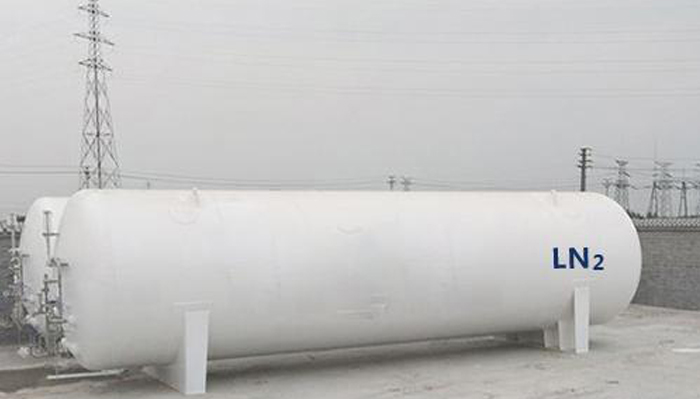Product Category
Characteristics of liquids stored in cryogenic tanks
Date: Dec 03, 2019


The cryogenic liquid vacuum storage tank is a jacketed vacuum powder insulated pressure vessel specially used for storing and supplying cryogenic liquefied gas (such as liquid nitrogen, liquid oxygen, liquid argon, liquid carbon dioxide, etc.) It has been widely used in industrial production and daily life.
Low temperature liquids have dangerous characteristics such as lower boiling point, larger expansion, stronger suffocation and strong oxidation. Therefore, it must be stored in a cryogenic liquid storage tank that conforms to national standards.
1) The boiling point of low temperature liquids at a pressure of 101.3KPa: liquid nitrogen is -196 ° C, liquid oxygen is -183 ° C, and liquid argon is -186 ° C. When in contact with the human body, it can cause severe frostbite to the skin and eyes. When a small amount of low-temperature liquid leaks or leaks inside the valve, it will absorb the surrounding ambient heat, and the leak point will quickly dew and frost, and in severe cases, it will freeze.
2) Cryogenic liquids receive high heat from the surrounding environment or a large amount of leakage to absorb surrounding energy, and their volume will expand due to rapid gasification. At 0 ° C and a pressure of 101.3KPa, the gas volume of 1L cryogenic liquid after vaporization: 674L for nitrogen, 800L for oxygen, and 780L for argon. In a closed container or pipeline, the internal pressure rises due to the vaporization of the low-temperature liquid, which easily causes the container or pipeline to overpressure and explode.
 3) In the environment around the cryogenic liquid tank, gas-rich regions are likely to form after the cryogenic liquid leaks and gasifies. If the concentration of nitrogen, argon, and carbon dioxide is large, it can easily cause suffocation. In addition, when the oxygen concentration is high, oxygen-enriched injury also occurs.
3) In the environment around the cryogenic liquid tank, gas-rich regions are likely to form after the cryogenic liquid leaks and gasifies. If the concentration of nitrogen, argon, and carbon dioxide is large, it can easily cause suffocation. In addition, when the oxygen concentration is high, oxygen-enriched injury also occurs.
4) Oxygen is a strong accelerant and has a strong oxidizing power. Liquid oxygen is close to combustibles, and it is easy to cause combustion when exposed to open flames. Contact with combustibles can cause knocking due to vibration, impact, etc . Mixing with combustibles has a potential explosion risk. Liquid oxygen can adhere to clothes and fabrics, and can cause flash ignition when it meets an ignition source, which can hurt people.
Low temperature liquids have dangerous characteristics such as lower boiling point, larger expansion, stronger suffocation and strong oxidation. Therefore, it must be stored in a cryogenic liquid storage tank that conforms to national standards.
1) The boiling point of low temperature liquids at a pressure of 101.3KPa: liquid nitrogen is -196 ° C, liquid oxygen is -183 ° C, and liquid argon is -186 ° C. When in contact with the human body, it can cause severe frostbite to the skin and eyes. When a small amount of low-temperature liquid leaks or leaks inside the valve, it will absorb the surrounding ambient heat, and the leak point will quickly dew and frost, and in severe cases, it will freeze.
2) Cryogenic liquids receive high heat from the surrounding environment or a large amount of leakage to absorb surrounding energy, and their volume will expand due to rapid gasification. At 0 ° C and a pressure of 101.3KPa, the gas volume of 1L cryogenic liquid after vaporization: 674L for nitrogen, 800L for oxygen, and 780L for argon. In a closed container or pipeline, the internal pressure rises due to the vaporization of the low-temperature liquid, which easily causes the container or pipeline to overpressure and explode.


4) Oxygen is a strong accelerant and has a strong oxidizing power. Liquid oxygen is close to combustibles, and it is easy to cause combustion when exposed to open flames. Contact with combustibles can cause knocking due to vibration, impact, etc . Mixing with combustibles has a potential explosion risk. Liquid oxygen can adhere to clothes and fabrics, and can cause flash ignition when it meets an ignition source, which can hurt people.
Last article:
Next article:
Send Your Inquiry
We not only provide a good product, but also provide high quality service. If you are interested in our products,
you can contact us in the following ways.
you can contact us in the following ways.















































































































